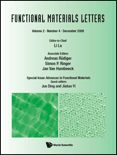
Functional Materials Letters
Scope & Guideline
Highlighting transformative findings in functional materials.
Introduction
Aims and Scopes
- Synthesis and Characterization of Functional Materials:
The journal focuses on novel methods for synthesizing functional materials, including nanomaterials, composites, and hybrid systems, while providing detailed characterization techniques to elucidate their properties. - Energy Storage and Conversion:
A core area of research involves materials for energy storage systems, such as batteries and supercapacitors, as well as catalysts for energy conversion processes, including fuel cells and solar energy applications. - Environmental Applications:
Research addressing the development of materials for environmental remediation, including photocatalysts for pollutant degradation and sensors for detecting environmental contaminants. - Smart and Responsive Materials:
The journal highlights studies on materials with tunable properties, such as hydrogels and shape-memory polymers, that respond to external stimuli for applications in soft robotics and biomedical devices. - Emerging Nanomaterials and Their Applications:
The focus is on nanostructured materials, including metal-organic frameworks and quantum dots, exploring their potential in various applications, particularly in electronics, photonics, and catalysis.
Trending and Emerging
- Advanced Energy Storage Solutions:
A significant trend is the focus on advanced materials for energy storage, particularly in the development of solid-state batteries and innovative electrode materials that enhance performance and safety. - Sustainable and Green Technologies:
Research on sustainable materials and processes is on the rise, with studies exploring eco-friendly synthesis methods and materials for environmental applications, including waste treatment and renewable energy. - Multifunctional Materials:
There is an increasing interest in multifunctional materials that combine properties such as conductivity, magnetism, and optical activity, leading to applications in sensors, actuators, and electronic devices. - 3D Printing and Additive Manufacturing of Functional Materials:
The integration of 3D printing techniques in the fabrication of functional materials is gaining traction, enabling the production of complex geometries and tailored properties for specific applications. - Health and Biomedical Applications:
There is a growing trend towards the development of functional materials for healthcare applications, including drug delivery systems, biosensors, and biocompatible materials for implants.
Declining or Waning
- Traditional Bulk Materials:
There is a noticeable decrease in publications focused on conventional bulk materials, as research trends shift towards nanostructured and composite materials that offer superior properties and functionalities. - Low-Performance Photocatalysts:
Research on simple, low-performance photocatalysts has waned, with a growing emphasis on developing advanced materials with enhanced photocatalytic efficiency and stability. - Basic Theoretical Studies Without Experimental Validation:
The journal has seen a decline in purely theoretical studies that lack experimental validation, reflecting a preference for comprehensive studies that combine theory with practical applications. - Limited Focus on Organic Materials:
There has been a reduced emphasis on organic materials for electronics and photonics, as the field moves towards exploring hybrid and inorganic materials that demonstrate superior performance.
Similar Journals
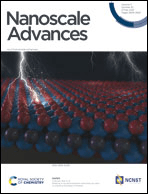
Nanoscale Advances
Transforming Ideas into Nanoscale Innovations.Nanoscale Advances, published by the Royal Society of Chemistry, stands out as a leading open-access journal dedicated to advancing the field of nanoscience and nanotechnology since its inception in 2018. With a specialized focus on areas such as atomic and molecular physics, bioengineering, chemistry, and materials science, this journal has consistently achieved top-tier rankings across several categories, reflecting its high-impact contribution to research and innovation. Currently classified in the Q1 quartile for both Atomic and Molecular Physics and Chemistry (Miscellaneous), and Q2 for Bioengineering, its prestige is underscored by impressive Scopus rankings, including a notable 34th position in General Engineering. With its commitment to disseminating high-quality research, Nanoscale Advances serves as an invaluable resource for researchers, professionals, and students alike, fostering collaboration and scholarly exchange in the rapidly evolving landscape of nanotechnology.
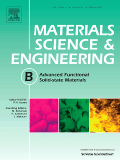
Materials Science and Engineering B-Advanced Functional Solid-State Materials
Pioneering Research in Advanced Material ScienceMaterials Science and Engineering B: Advanced Functional Solid-State Materials, published by Elsevier, stands as a pivotal platform in the realm of materials science, focusing on the development and characterization of advanced solid-state materials. With an ISSN of 0921-5107 and E-ISSN of 1873-4944, this journal operates out of the United Kingdom and addresses critical issues in condensed matter physics, mechanical engineering, and mechanics of materials. Its consistent recognition, evident in its Q2 quartile rankings across multiple engineering and physics categories and a respectable scope of convergence from 1988 to 2024, signifies its substantial contribution to the field. Researchers and professionals seeking a venue for cutting-edge work will appreciate the journal's commitment to advancing knowledge in functional materials, with its open access features ensuring that innovative findings are readily accessible. Join a community of leading scholars engaging with the latest advancements, shaping the future of materials science.

Nano Express
Fostering breakthroughs in biomaterials and beyond.Nano Express is an esteemed open-access journal published by IOP Publishing Ltd, dedicated to advancing research in the fields of nanotechnology and materials science. Since its launch in 2020, the journal has swiftly established itself as a vital resource for researchers and professionals, garnering significant recognition in various domains, including biomaterials, electronic, optical and magnetic materials, and polymers and plastics. With a commendable categorization in Scopus quartiles, it ranks in Q2 for Electronic, Optical and Magnetic Materials, and maintains a top percentile in several others, exemplifying its commitment to high-quality research dissemination. Located in the United Kingdom, this journal fosters a global dialogue among experts and newcomers alike, facilitating open access to innovative research that drives the future of nanotechnology. By offering a platform for groundbreaking studies and reviews, Nano Express aims to bridge the gap between theoretical understanding and practical application, championing the development of next-generation materials that have the potential to transform various industries.

Accounts of Materials Research
Leading the charge in open-access materials innovation.Accounts of Materials Research is a premier journal published by the American Chemical Society, focusing on the multidimensional field of materials science. With a robust impact factor and a commitment to open-access research, it serves as a vital platform for leading-edge discoveries from 2020 to 2024. The journal has rapidly ascended to the top quartile in multiple categories, including Chemical Engineering, Materials Chemistry, and Polymers and Plastics, demonstrating its significant influence within the academic community. Recognized by Scopus as a key resource—with remarkable rankings that place it in the 95th percentile of its field—Accounts of Materials Research is devoted to publishing high-quality, innovative research that addresses critical challenges in materials development and implementation. This journal is essential for researchers, professionals, and students seeking to stay informed about the latest advancements and collaborative opportunities within the interdisciplinary landscape of materials science.
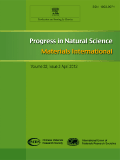
Progress in Natural Science-Materials International
Exploring the Frontiers of Materials InnovationProgress in Natural Science-Materials International is a leading journal published by Elsevier Science Inc, dedicated to advancing the field of materials science through high-quality research and innovative studies. With an impressive impact factor and categorized in the top Q1 quartiles for both Materials Science and Multidisciplinary categories as of 2023, this journal is recognized for its significant contribution to the academic community. Operating as an Open Access publication since 2008, it ensures that cutting-edge research is readily available to a global audience, fostering collaboration and knowledge sharing among researchers, professionals, and students alike. Covering a broad spectrum of topics from the synthesis and characterization of materials to their application in various fields, Progress in Natural Science-Materials International serves as a vital platform for disseminating findings that propel the discipline forward. With its rich history dating back to its inception in 1996 and plans to continue until 2024, this journal is committed to providing a robust avenue for scholarly discourse and innovation.

JOURNAL OF INORGANIC MATERIALS
Connecting Academics and Industry in Inorganic StudiesJOURNAL OF INORGANIC MATERIALS, published by SCIENCE PRESS, is a prominent platform dedicated to the dissemination of research in the fields of inorganic chemistry and materials science. With a history spanning over three decades since its inception in 1993, this journal has become a key resource for academics and industry professionals alike, aiming to advance the understanding of inorganic materials through rigorous research findings. It operates under a strict peer-review process, ensuring high-quality contributions that uphold its reputation within the scientific community. Currently ranking in the Q3 category for both inorganic chemistry and miscellaneous materials science, the journal holds a significant position in Scopus rankings, further solidifying its relevance and impact. Researchers will find this journal an essential avenue for the latest discoveries and methodologies in inorganic materials, fostering innovation and collaboration in a vital area of science.

ADVANCED MATERIALS
Driving Excellence in Materials ResearchAdvanced Materials, published by Wiley-VCH Verlag GmbH, is a premier academic journal that serves as a crucial platform for cutting-edge research in the field of materials science and engineering. With an impressive impact factor and ranking among the top tiers in various categories, including Materials Science, Mechanical Engineering, and Nanoscience, this journal is recognized for its high-quality contributions and relevance to contemporary research challenges. Spanning from 1989 to 2024, Advanced Materials not only features groundbreaking studies but also provides insights into innovative applications and advancements in material design and engineering. Researchers, professionals, and students alike will benefit from the rigorous peer-review process and diverse range of topics covered, making it an indispensable resource for those aiming to stay at the forefront of materials science innovation.
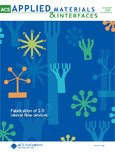
ACS Applied Materials & Interfaces
Connecting Science and Technology for a Sustainable FutureACS Applied Materials & Interfaces, published by the American Chemical Society, stands as a leading journal in the field of applied materials, nanotechnology, and interdisciplinary research in medicine. With an impressive Impact Factor that places it in the Q1 category across Materials Science, Medicine, and Nanoscience and Nanotechnology, this journal consistently ranks among the top tier, evidencing its significance and influence in advancing scientific knowledge. The journal’s scopus ranking of 33 out of 463 in General Materials Science further underscores its critical role in disseminating innovative and high-quality research. Although it is not an open-access journal, a diverse range of access options is available, ensuring that vital research findings are accessible to a broad audience of researchers, professionals, and students. Targeting breakthroughs in the synthesis, characterization, and application of materials and interfaces, ACS Applied Materials & Interfaces serves as a pivotal platform for publishing cutting-edge studies essential for future technological advancements.

JOURNAL OF MATERIALS SCIENCE
Inspiring Excellence in Materials EngineeringJOURNAL OF MATERIALS SCIENCE, published by SPRINGER, stands as a highly regarded periodical in the field of materials science, delivering impactful research since its inception in 1966. With an impressive Q1 ranking in both Mechanical Engineering and Mechanics of Materials, alongside strong Q2 positions in Ceramics, Composites, and General Materials Science, this journal serves as a pivotal resource for scholars and practitioners alike. It offers insightful contributions that span a diverse range of topics, from emerging materials to advanced applications in engineering. With a robust Scopus ranking reflecting its global influence—ranking 91 out of 672 in Mechanical Engineering and 63 out of 398 in Mechanics of Materials—the JOURNAL OF MATERIALS SCIENCE maintains an essential role in advancing the understanding and innovation within the discipline. Researchers, professionals, and students are encouraged to access this esteemed journal to keep abreast of groundbreaking findings and methodologies that shape the future of materials science.

Frontiers in Materials
Innovating through Collaborative Research.Frontiers in Materials, an esteemed journal published by FRONTIERS MEDIA SA, is a leading platform in the field of Materials Science, with a notable impact factor placing it in the Q2 category of its discipline as of 2023. Since its establishment as an Open Access journal in 2014, it has fostered considerable academic exchange, allowing researchers from around the globe to share their innovative findings and insights. Based in Lausanne, Switzerland, this journal not only emphasizes high-quality peer-reviewed articles but also prioritizes rapid dissemination of research, as evidenced by its commendable Scopus ranking of #62 out of 196 in Materials Science (miscellaneous). By consistently striving to bridge the gap between academia and practical applications, Frontiers in Materials serves as an invaluable resource for researchers, professionals, and students seeking to delve into cutting-edge advancements and transformative applications in materials science.